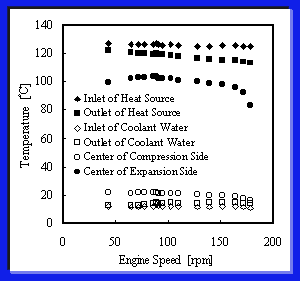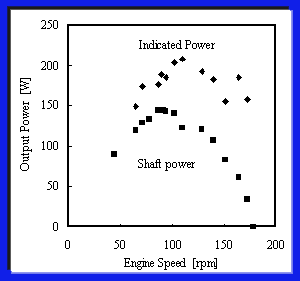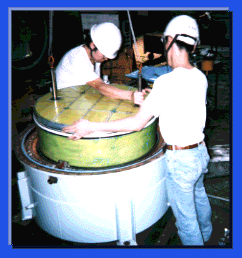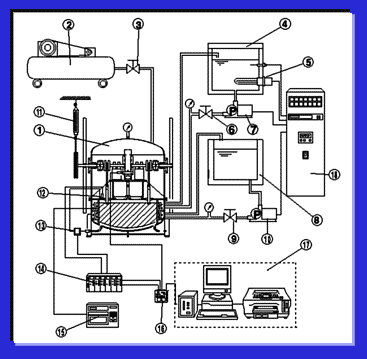

Temperatures of the engine running (right) and engine power (Left) under atomsferic of buffer pressure.


 Japanese
JapaneseWhen it is manufactured from until the present time, a various improvement is donated by 300 W class low temperature degree difference Stirling engine, and an experiment is continued at present. Concerning these experiments, we may introduce the method or a portion of the engine performance to be obtained.
 A performance test of an engine is done as follows generally. In high-temperature heat-source that is supplied an engine with, the ethylene glycole heated for a stationary temperature in constant temperature water bath is used, and water is used for low heat-source. And it is adopted a way that both heat-source circulate between engine inside and constant temperature water bath by pump. These amount of flow are adjusted by flow control valve to stasionary. Also, gas temperature and heat-source temperature are measured by K type thermo couple arranged each point of engine, and dysplaied and recorded by the hybrid recorder. The pressure in engine is measured by the pressure transducer installed on a cooling wall of the low temperature space side and by Differential Pressure Gauge installed between compression space and expansion space. Output power is calculated by shaft torque, mesured by braking output shaft, and engine speed. A buffer pressure introduces to buffer space by a compressor and adjusts it suitably by pressure control valve.
A performance test of an engine is done as follows generally. In high-temperature heat-source that is supplied an engine with, the ethylene glycole heated for a stationary temperature in constant temperature water bath is used, and water is used for low heat-source. And it is adopted a way that both heat-source circulate between engine inside and constant temperature water bath by pump. These amount of flow are adjusted by flow control valve to stasionary. Also, gas temperature and heat-source temperature are measured by K type thermo couple arranged each point of engine, and dysplaied and recorded by the hybrid recorder. The pressure in engine is measured by the pressure transducer installed on a cooling wall of the low temperature space side and by Differential Pressure Gauge installed between compression space and expansion space. Output power is calculated by shaft torque, mesured by braking output shaft, and engine speed. A buffer pressure introduces to buffer space by a compressor and adjusts it suitably by pressure control valve.
| 1 | Test Engine | 2 | Air Compressor | 3 | Pressure Control Valve |
| 4 | Constant Temperature Water Bath | 5 | Heater for Heat Source | 6 | Flow Control Valve |
| 7 | Pomp for Heat Source | 8 | Water Bath | 9 | Flow Control Valve |
| 10 | Pomp for Coolant Water | 11 | Spring Balancer | 12 | Pressure Transducer of Cold End |
| 13 | Differential Pressure Gauge | 14 | Strain Amplifier | 15 | Hybrid Recorder |
| 16 | A/D Converter | 17 | Personal Computer | 18 | Central Control Panel |
| Heat Source: | |
|---|---|
| Fluid Material | Ethren Glycol |
| Temperature | 130 degree Celsius |
| Flow Volume | 20 l/min | Heat Sink: |
| Fluid Material | Water |
| Temperature | 15 degree Celsius |
| Flow Volume | 20 l/min |


Temperatures of the engine running (right) and engine power (Left) under atomsferic of buffer pressure.
 Structure of 300 W class low temperature difference Stirling engine
Structure of 300 W class low temperature difference Stirling engine
 300 W class low temperature difference Stirling engine
300 W class low temperature difference Stirling engine
 Return to Stirling Engines of Saitama University
Return to Stirling Engines of Saitama University
 Return to Stirling Engiene Home Page Academic Edition
Return to Stirling Engiene Home Page Academic Edition